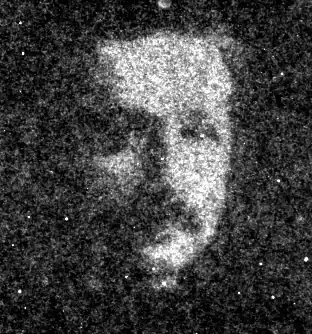Light-Reactive Bacteria Create Miniature ‘Mona Lisa’ Replica
Researchers transformed swimming bacteria into replica of the da Vinci masterpiece, morphing likenesses of Albert Einstein, Charles Darwin
:focal(256x198:257x199)/https://tf-cmsv2-smithsonianmag-media.s3.amazonaws.com/filer/53/ac/53ac3390-2fd9-491f-8a2d-96ca7e669e56/mona_lisa.jpg)
Despite its association with tainted lettuce and potentially life-threatening infections, the Escherichia coli strain of bacteria is usually harmless—and surprisingly versatile. As Ryan F. Mandelbaum reports for Gizmodo, a team of Italian researchers recently capitalized on E. coli’s swimming skills (the bacteria can race across distances 10 times their length in just one second) to produce a millimetric replica of the world’s most famous work of art, Leonardo da Vinci’s “Mona Lisa.”
The scientists’ research, newly detailed in eLife, revolves around E. coli’s flagellum, or tail. This minuscule motor propels the bacteria’s movement, enabling them to form distinct patterns, and can be controlled with the help of a light-sensitive protein called proteorhodopsin.
Although the protein is typically found in ocean-dwelling bacteria, Digital Trends’ Dyllan Furness writes that the team used genetic engineering to introduce it to E. coli and other bacteria strains. No longer reliant on oxygen to fuel their swims, these modified bacteria looked to light to guide their movements.
“Much like pedestrians who slow down their walking speed when they encounter a crowd, or cars that are stuck in traffic, swimming bacteria will spend more time in slower regions than in faster ones," lead author Giacomo Frangipane, a physicist at the University of Rome in Italy, said in a statement. "We wanted to exploit this phenomenon to see if we could shape the concentration of bacteria using light."
To create their mini “Mona Lisa,” the researchers projected a negative image of the Renaissance masterpiece onto a “stage” housing the bacteria. According to Gizmodo’s Mandelbaum, slower-moving E. coli flocked to areas receiving less light, crowding each other and producing dense patterns that appear as the darker regions of the final portrait. Faster-moving bacteria, on the other hand, received more light and moved farther apart, generating the portrait’s lighter shades.
“If we want to ‘paint’ a white stroke—where bacteria is the paint—we need to decrease the speed of bacteria by locally decreasing light intensity in that region so that bacteria slow down and accumulate there,” study co-author Roberto Di Leonardo, a physicist also at the University of Rome, tells Digital Trends’ Furness.

Although the E. coli produced a recognizable rendition of da Vinci’s painting, the bacteria experienced delayed responses to variations in light, leading the final image to turn out blurry, according to a press release. To rectify this issue, the team set their projection on a 20-second loop, enabling them to continually compare the bacterial formations to the desired outcome. The result: a “photokinetic” bacterial cell layer capable of producing nearly perfect replicas of black-and-white images.
In addition to recreating the “Mona Lisa,” the researchers guided the E. coli into a face-morphing portrait that transformed from a likeness of Albert Einstein to that of Charles Darwin in just five minutes.
While these artistic exploits are impressive, Di Leonardo notes that they are not the end goal of the team’s research: Instead, the scientists hope to utilize genetically modified bacteria as microscopic building blocks.
“In physics and engineering applications, these bacteria could be used as a biodegradable material for optical 3D printing of sub-millimeter microstructures,” Di Leonardo explains to Furness. “On the other hand, dynamical control of bacteria could be exploited for in-vitro biomedical applications for isolating, sorting, and transporting larger cells for analysis or diagnostic purposes on the single-cell level inside miniaturized laboratories.”
/https://tf-cmsv2-smithsonianmag-media.s3.amazonaws.com/accounts/headshot/mellon.png)
/https://tf-cmsv2-smithsonianmag-media.s3.amazonaws.com/accounts/headshot/mellon.png)